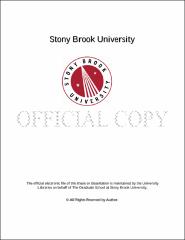| dc.identifier.uri | http://hdl.handle.net/11401/77666 | |
| dc.description.sponsorship | This work is sponsored by the Stony Brook University Graduate School in compliance with the requirements for completion of degree. | en_US |
| dc.format | Monograph | |
| dc.format.medium | Electronic Resource | en_US |
| dc.language.iso | en_US | |
| dc.publisher | The Graduate School, Stony Brook University: Stony Brook, NY. | |
| dc.type | Dissertation | |
| dcterms.abstract | The global iron and sulfur cycles are linked to some of the most ancient metabolisms on our planet, and, therefore, possibly other planetary bodies. They are also linked to some of our most pressing environmental problems on Earth. Understanding their interactions and monitoring their occurrence is, therefore, an important aspect of exploring planetary bodies and sustainable resource management. This dissertation reports investigations into the identification and analysis of iron and sulfur bearing phases in three extreme environments: Acid-gas/CO<sub>2</sub> co-sequestration, acid mine drainage (AMD), and Mars. H<sub>2</sub>S and SO<sub>2</sub> (acid gases) are often co-contaminants in CO<sub>2</sub> streams. Co-sequestration of these gases lowers the cost of sequestration, but these sulfur-bearing gases can increase the reactivity of the injection site, particularly if iron-bearing minerals are present. Analyzing iron and sulfur reactivity in these systems is, therefore, crucial to further development of carbon sequestration technology. Experiments examining the simulated co-injection of CO<sub>2</sub>, H<sub>2</sub>S and/or SO<sub>2</sub> are reported for hematite-bearing and hematite-free sandstones. The iron mineralogy of the sandstones, which is monitored using Mössbauer spectroscopy, is key to the reactivity of the sandstones. Jarosite is an iron sulfate found primarily in areas of AMD, but it has also been identified on Mars. On Earth, using remote sensing to quantify jarosite concentrations could be a time and cost saving measure for AMD detection and cleanup. On Mars, quantifying jarosite may help constrain surface processes responsible for its formation. Quantitative mineral abundance determination using remote sensing requires knowledge of the optical constants of minerals present on the surface. The optical constants of jarosite are determined and the methodology for optical constant determination (Hapke formulation), including an open source computer code, is reported. | |
| dcterms.abstract | The global iron and sulfur cycles are linked to some of the most ancient metabolisms on our planet, and, therefore, possibly other planetary bodies. They are also linked to some of our most pressing environmental problems on Earth. Understanding their interactions and monitoring their occurrence is, therefore, an important aspect of exploring planetary bodies and sustainable resource management. This dissertation reports investigations into the identification and analysis of iron and sulfur bearing phases in three extreme environments: Acid-gas/CO<sub>2</sub> co-sequestration, acid mine drainage (AMD), and Mars. H<sub>2</sub>S and SO<sub>2</sub> (acid gases) are often co-contaminants in CO<sub>2</sub> streams. Co-sequestration of these gases lowers the cost of sequestration, but these sulfur-bearing gases can increase the reactivity of the injection site, particularly if iron-bearing minerals are present. Analyzing iron and sulfur reactivity in these systems is, therefore, crucial to further development of carbon sequestration technology. Experiments examining the simulated co-injection of CO<sub>2</sub>, H<sub>2</sub>S and/or SO<sub>2</sub> are reported for hematite-bearing and hematite-free sandstones. The iron mineralogy of the sandstones, which is monitored using Mössbauer spectroscopy, is key to the reactivity of the sandstones. Jarosite is an iron sulfate found primarily in areas of AMD, but it has also been identified on Mars. On Earth, using remote sensing to quantify jarosite concentrations could be a time and cost saving measure for AMD detection and cleanup. On Mars, quantifying jarosite may help constrain surface processes responsible for its formation. Quantitative mineral abundance determination using remote sensing requires knowledge of the optical constants of minerals present on the surface. The optical constants of jarosite are determined and the methodology for optical constant determination (Hapke formulation), including an open source computer code, is reported. | |
| dcterms.available | 2017-09-20T16:53:15Z | |
| dcterms.contributor | Glotch, Timothy | en_US |
| dcterms.contributor | Reeder, Richard | en_US |
| dcterms.contributor | Schoonen, Martin | en_US |
| dcterms.contributor | Rogers, Deanne | en_US |
| dcterms.contributor | Cloutis, Ed. | en_US |
| dcterms.creator | Sklute, Elizabeth Christ | |
| dcterms.dateAccepted | 2017-09-20T16:53:15Z | |
| dcterms.dateSubmitted | 2017-09-20T16:53:15Z | |
| dcterms.description | Department of Geosciences. | en_US |
| dcterms.extent | 433 pg. | en_US |
| dcterms.format | Monograph | |
| dcterms.format | Application/PDF | en_US |
| dcterms.identifier | http://hdl.handle.net/11401/77666 | |
| dcterms.issued | 2014-12-01 | |
| dcterms.language | en_US | |
| dcterms.provenance | Made available in DSpace on 2017-09-20T16:53:15Z (GMT). No. of bitstreams: 1
Sklute_grad.sunysb_0771E_11987.pdf: 19141469 bytes, checksum: a060bf601ec3d687bf1fc271ec474a5a (MD5)
Previous issue date: 1 | en |
| dcterms.publisher | The Graduate School, Stony Brook University: Stony Brook, NY. | |
| dcterms.subject | Amorphous Iron Sulfates, Geologic Carbon Sequestration, Hapke Radiative Transfer, Jarosite Optical Constants, Mars, Matlab | |
| dcterms.subject | Geochemistry | |
| dcterms.title | On the Subject of Analyzing Iron and Sulfur Bearing Minerals from Three Extreme Environments: Geological Sequestration, Acid Mine Drainage, and Mars | |
| dcterms.type | Dissertation | |

